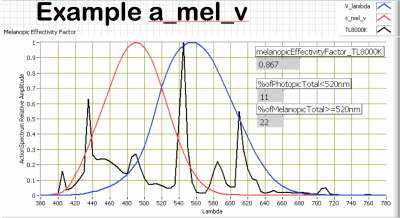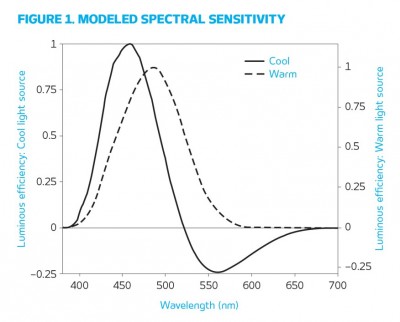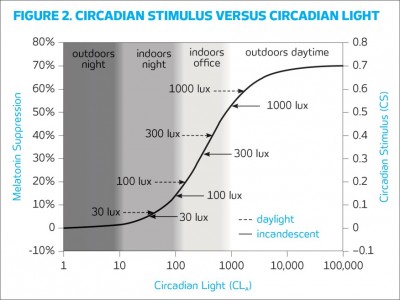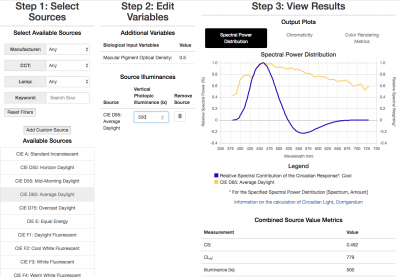How effective is light on the circadian rhythm of humans? Use the CS.
Posted by Marcel van der Steen in Explanation 5 Comments» The circadian rhythm of humans is of importance for us; a.o, it takes care of our recovery. This rhythm can be influenced by the usage of light. The level of influence can be calculated by using a method developed by the Lighting Research Center (LRC), that uses the Circadian Stimulus value.
The circadian rhythm of humans is of importance for us; a.o, it takes care of our recovery. This rhythm can be influenced by the usage of light. The level of influence can be calculated by using a method developed by the Lighting Research Center (LRC), that uses the Circadian Stimulus value.
Introduction
The circadian rhythm has a periodic length of about 1 day. It is of importance for humans since it arranges a lot of biological processes, the timely release of certain hormones and therefore makes processes work that we need to recover ourselves. We need sleep that is well and sufficient, but also we need times of alertness and wake. By using (natural and or artificial) light at the right time we can adjust this circadian rhythm with the day/night rhythm that is outside (and to which our regular (alarm) clocks are aligned). Since a lot of us will have to do with artificial light only (at least a big part of the year), it is important to use the artifical light such that it aligns our circadian rhythm well with the outside world we live in.
This article will explain how well light of a certain lamp can influence the circadian rhythm of humans. In an earlier article I have explained that, using two norms, we assumed a certain photopigment in a certain light receptor (melanopsin in the gangion cells) could be used to determine the effectiveness of light. We would then weigh the spectrum of the light of the lamp in investigation with the sensitivity spectrum of this photopigment and the result would then be an effectivity number indicating how much of an influence the light would have on our circadian rhythm.
The mentioned norms stem from 2013 and 2015. Since that time more research has been done and the mentioned LRC of the Rensselaer Polytechnical Institute in Troy, New York, came to the conclusion that the sensitivity spectrum of one photopigment is not enough to determine the level of influence, but instead more receptors are needed and sum their behaviour as well. One of these receptors could possibly saturate and thereby the effect would be depending also on the amount of light used.
In the remainder of this article I explain the method that can be used to convert light of any spectrum into a value of Circadian Stimulus (CS). For that we need to know the illuminance value in lux at the vertical plane of the eye and we assume a duration of 1 hour.
Melanopic effects
The norm 67600-2013 explained the amount of light (in lux) needed on the eye and at what time-instants during the day, to work well in certain applications (like in a classroom, in a nursery room, an office etc). In order to have an effect, at least 250 lux at the vertical plane of the eye, coming from an FL tube of 8000K during 15 minutes, was needed. Only at that level or more there would be an noticeable melanopical effect and with that an effect on the circadian rhythm.
In a previous article I explained that the light of the mentioned 8000K FL tube could be converted into a melanopic effect factor (0.867 for this tube). So when an other lamp with different spectrum is measured, then also that spectrum could be converted into a melanopic effect factor and these factors can then be compared with each other. The highest effect factor would indicate the most efficient spectrum which would then need less (photopic) lux at eye level to be of influence on the circadian rhythm.
An example: the FL tube had a melanopic effect of 0.867. A certain LED lamp of 3075K had this value of 0.387. This LED lamp was less effective in influencing the circadian rhythm, for it would need 0.867/0.387 = 2.25 x as much light vertically at eye level for 15 minutes to be as effective.
The example above indicates with the black line, the spectrum of the afore mentioned 8000K FL tube. That was weighted agains the sensitivity spectrum of melanopsin (red curve). This could then be compared to the light spectrum weighted result against the photosensitivity curve (blue) and the division between these to is the so called melanopic effectivity factor.
Circadian Stimulus (CS)
What was missing in the aforementioned approach were a number of things. One was hat people did not know the change in amount of effect that more, or less, illuminance would have on the circadian rhythm. Secondly the LRC standpoint is that not only Ganglion cells with the melanopsin photopigment alone would have an influence but also certain cones (S-cones) and the rods themselves (until these are driven in saturation at high light levels). The LRC explain in a number of documents (links below) that the weighting must be done differently. They derive, from a number of lux vertically at eye level, via calculations on the spectrum of the light applied, a Circadian Stimulus effect (CS-number). This latter having a value between 0 and 0.7. To simplify its results: all below 0.1 has no real influence, and all above 0.3 does (assuming a 1 hour exposure).
Analysing the spectrum of the used light we determine whether it is a warm-source or a cold source. A warm source is only weighted against the melanopsin sensitivity spectrum (as previously done) and a cold source spectrum is weighed also against the effects of the S-cones and rods. These two sensitivity curves are indicated in the figure below.
After the weighting operation a conversion of the result is done to a CS value. A high CS value can be obtained both by a high illuminance value coming from a warm light source, as well as a lower illuminance value from a cold light source.
The figure above indicates that at 30 lux at eye level, there is no much difference in CS value between a cold and a warm light source. This difference however is much bigger at 100, 300 and still at 1,000 lux. At even higher lux values we see saturation of the effect.
Also the figure indicates that the CS value corresponds to a level of suppression of melatonine. This is the so called effect on the circadian rhythm that is mentioned in this article.
Calculator
The LRC has made available an excel file and also a web-calculator, to calculate the CS-value and the circadian light value (CLA). This can be determined of a number of well know standardised spectra but also from your own inserted spectrum and a superposition of spectra.
In a few steps you select the desired spectrum (here D65 day light is chosen), you choose the illuminance value at vertical eye level (here 500 lux), and in step 3 the results show whether the light source is cold or warm (here cold, indicated with the blue spectral line) and the spectrum of the light itself (here in yellow, the D65 light spectrum). The CLA and CS value are also shown (resp 779 and 0.492). One can even add different spectra with each their own lux value, and the sum of the results are shown.
One can play endlessly with lux values and see what that does to the CS result. Know that a value of CS < 0.1 does not have a mentionable effect and a value > 0.3 does. This all with an exposure time of 1 hour.
In the calculator one can see two links that explain more about the calculation (document from 2012) and the corrigendum. Beware, the calculator does have small differences in its own calculation, which could be found in the excel file. This latter is of a much more recent date, from end 2017.
The calculator also explains about the different parameters, such as these two frequently mentioned in this article:
Circadian Light, CLA is the irradiance at the cornea weighted to reflect the spectral sensitivity of the human circadian system as measured by acute melatonin suppression after a 1-hour exposure.
Circadians Stimulus (CS): is the calculated effectiveness of the spectrally weighted irradiance at the cornea from threshold (CS = 0.1) to saturation (CS = 0.7), assuming a fixed duration of exposure of 1 hour.
OliNo measurements
In the full measurement done by OliNo already included is the melanopic effect value. As it seems this value is not enough or well suited to determine the effect on the circadian rhythm of humans. For that, the CS value would give more information and I will add it to every full measurement report. It will be in the form of a table where I take a number of lux values representing the vertical illuminance at the eye and in the column next to it I give the corresponding CS value. The lux values that are taken come from the EN 12464-1 norm that presents a row of increasing values that represent the smallest subjective perceivable difference.
With help of this table one can see how the lux value of the lamp tested (with its specific spectral composition) will affect the CS value and therewith the effect on the circadian rhythm.
Referenties
Designing with Circadian Stimulus
Modelling the spectral sensitivity of the human circadian system
Web calculator voor CS en CL_a waarde
Quantifying Circadian Light and its Impact









5 replies on “How effective is light on the circadian rhythm of humans? Use the CS.”
The circadian rhythm plays a vital role in human recovery, influencing biological processes and hormone release. Proper lighting, whether natural or artificial, can align our internal rhythm with the external day/night cycle. The Lighting Research Center (LRC) has developed a method to evaluate how different light spectra affect circadian stimulus (CS) values. This understanding is essential for optimizing light exposure, especially in environments like Monkey Mart, where artificial light predominates.
Monkey Martz is a cute game where monkeys run a small store. Stock items, serve happy customers, and make the shop bigger.
Understanding light’s impact on our circadian rhythm is crucial, especially in places like omegle. The Lighting Research Center offers insights on how light spectra influence our internal clocks. Just as light can connect us to our inner selves, sometimes we seek external connections too. If you’re looking for random chats and want to try something new, perhaps give omegle a try. Looking for an alternative, you can try omegle at the following URL https://omeglechat.online/.
You’re right, understanding how light affects our circadian rhythm is crucial for well-being. The LRC’s Circadian Stimulus (CS) method offers a valuable tool for assessing lighting’s impact, considering multiple photoreceptors beyond just melanopsin. This is particularly relevant as we increasingly rely on artificial light. Speaking of connecting, if you’re looking to connect with others, some people find platforms like omegle interesting, though consider exploring options and staying safe at resources such as https://omeglechat.online/.
Understanding circadian stimulus (CS) values, as researched by the Lighting Research Center, is key to optimizing light exposure for better recovery and hormonal balance. Light, vital in environments like Monkey Mart, influences our natural day/night cycle. Speaking of connecting with others, have you ever wanted random chats? Just like aligning light exposure, some find excitement in spontaneous conversation. If you’re looking for a similar outlet, check out omegle at https://omeglechat.online/